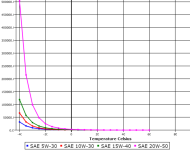RalphVa
Super Member
- Joined
- Dec 19, 2003
- Messages
- 7,885
- Location
- Charlottesville, VA, USA
- Tractor
- JD 2025R, previously Gravely 5650 & JD 4010 & JD 1025R
If you want to see how oil viscosity changes with temperature, here's a good site: C:\Users\user\Documents\Car Stuff\Viscosity_temperature_oil_plots.png
Below is a plot when I put in -40 as the minimum temperature (-40 is same in F or C).
At 1,000,000 Cs, no oil will flow. These will all flow at -40, but the oil pump will have trouble picking up suction on any but the very lightest short before many seconds or running. In the meantime, the upper valve train can go totally dry and actually start smoking. Imperial Oil, Exxon's oil research arm prior to their moving it all to Baton Rouge, did research on this many years back whereby they started a Chrysler 4 cylinder with transparent valve cover in a -40 room using various oils. There was quite a long delay in getting oil flow from all oils except a 0wxx oil. No dino oil could be made at that time to 0wxx specs and still meet volatility specs, particularly the stringent Noack one being tested at that time.
Many oil pumps also will require more energy to pump the oil if the oil is very viscous. Most oil pumps are designed to pump too much oil, with the excess going on pressure bypass back to the sump. This pumping energy, especially on startup, is mainly what can be reduced by use of synthetic oil. However, synthetic also seems to be more slippery (probably due to much fewer additives that may not be as "oil" like) at operating temperature and increases hp there. This is the main reason why car racers use synthetic. Of course, it will not break down so readily under the rigours of racing like dino oil with lots of additives.
Ralph
Below is a plot when I put in -40 as the minimum temperature (-40 is same in F or C).
At 1,000,000 Cs, no oil will flow. These will all flow at -40, but the oil pump will have trouble picking up suction on any but the very lightest short before many seconds or running. In the meantime, the upper valve train can go totally dry and actually start smoking. Imperial Oil, Exxon's oil research arm prior to their moving it all to Baton Rouge, did research on this many years back whereby they started a Chrysler 4 cylinder with transparent valve cover in a -40 room using various oils. There was quite a long delay in getting oil flow from all oils except a 0wxx oil. No dino oil could be made at that time to 0wxx specs and still meet volatility specs, particularly the stringent Noack one being tested at that time.
Many oil pumps also will require more energy to pump the oil if the oil is very viscous. Most oil pumps are designed to pump too much oil, with the excess going on pressure bypass back to the sump. This pumping energy, especially on startup, is mainly what can be reduced by use of synthetic oil. However, synthetic also seems to be more slippery (probably due to much fewer additives that may not be as "oil" like) at operating temperature and increases hp there. This is the main reason why car racers use synthetic. Of course, it will not break down so readily under the rigours of racing like dino oil with lots of additives.
Ralph
